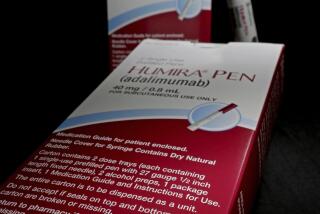Hope Sprigs Eternal : Biotech Firm Wants to Grow Herbal Medicine Business
- Share via
In the tastefully decorated lobby of Irvine-based PharmaPrint, a fledgling biotech company, hangs an offbeat piece of corporate art: two sprigs of mistletoe, nicely framed.
A few feet away something even more unusual is displayed: the first U.S. patent issued for a pharmaceutical version of an herbal remedy--that mistletoe, which is used in Europe to fight AIDS and cancer.
In recent months, PharmaPrint has collected two patents for mistletoe-based extracts, $15 million from an initial public offering and the endorsement from a World Health Organization group of the company’s technology, called PharmaPrinting.
PharmaPrinting, which was developed at USC by PharmaPrint’s chairman, precisely identifies the components that make an herbal remedy effective.
That makes it possible, for the first time, to standardize, patent and clinically test herbal medicines believed, but never scientifically proven, to be effective. A patented version of an herbal remedy could then receive approval by government agencies, be prescribed by doctors and, according to PharmaPrint’s ambitious plans, help swell the worldwide herbal medicine business.
“With the PharmaPrint technology, we’re expecting to sharply increase the $60-billion market” for herbal medicines worldwide, said Elliot P. Friedman, PharmaPrint chief executive. “In this country, 90% of the people won’t take something unless it’s FDA-approved and prescribed by a doctor, so it vastly increases the market.”
In fact, about one of every four existing drugs is derived from plants, including aspirin, which comes from the willow tree, and Taxol, used to treat cancer, which comes from the yew tree.
But those drugs are based on the healing powers of a single molecule in a plant. Single molecules can be isolated and tested relatively easily. Natural remedies that work thanks to the interaction of multiple molecules are another story, Friedman said.
Until the PharmaPrinting technology was developed by Tasneem A. Khwaja, a USC professor of pathology who worked on it for 20 years, scientists had been unable to identify and measure each active component in multi-molecule natural medicines, demonstrate how they work together and whether they are effective, Friedman said.
“About 80% of all therapies in use in many countries are made from herbs according to tradition and experience, and most of these are multi-molecule herbal medicines that previously could not be standardized into pharmaceutical versions,” said Ivor Ralph Edwards, director of drug monitoring for the World Health Organization’s Collaborating Centre for Drug Monitoring. “As a result, it was previously impossible to clinically establish whether or not they perform as intended, and some may even cause harm if used incorrectly.”
PharmaPrinting is the only system now available that can identify the components of multi-molecule natural medicines completely enough to qualify the medicines for a patent, he said. A patent is a critical, early step in the long process that ultimately ends with submitting a drug for approval to the Food and Drug Administration.
“We are hopeful that being able to create pharmaceutical versions of multi-molecule herbal medicines will make available a broad array of effective new therapies,” said Clive R. Taylor, chairman of the department of pathology and laboratory medicine at USC’s School of Medicine and a member of PharmaPrint’s scientific advisory board.
Using PharmaPrinting, the company has developed and patented two pharmaceutical mixtures derived from mistletoe, which will be used to treat HIV patients. Clinical trials of the extracts are expected to begin soon overseas, Friedman said.
PharmaPrint is one of several companies looking for ways to standardize medicines made from plants, industry analysts said. Such herbal products, which might be sold overseas as drugs, are peddled in the United States in natural food stores and supermarkets as dietary supplements or vitamins.
“There’s not a lot of clinical data available on these products,” an FDA spokesman noted. “It’s a situation where a lot of people are curious about them, but there isn’t a lot of scientific information we have to validate them.”
PharmaPrint, working with scientists at the University of Miami, is also developing an extract from the saw palmetto berry that would be used to treat men with enlarged prostate glands.
In each case, PharmaPrint contracts out the lab work--the mistletoe extracts are being prepared by the Biotechnology Research Institute of Canada’s National Research Council--as well as the clinical testing. PharmaPrint itself, which incorporated in 1994, has about a dozen employees.
USC continues to own the rights to the PharmaPrinting technology, owns a small percentage of the company’s stock and also will do some of PharmaPrint’s future research work, Taylor said.
Getting the first-ever U.S. patents for pharmaceutical versions of herbal remedies was a big step for PharmaPrint, which recently changed its name from ABT Global Pharmaceutical.
So was getting the endorsement of the World Health Organization group, which in early December launched a global program to standardize information on herbal medicines, which vary in name and therapeutic use from country to country. PharmaPrint will be participating in the WHO standardization project, the company said.
To be sure, bringing any new drug to market is a time-consuming and expensive proposition. PharmaPrint acknowledges that there is no assurance it will ever have a drug to sell.
PharmaPrint has yet to post any revenue or earnings. For the three months ended Sept. 30, the latest period for which figures are available, the company lost $4.5 million, or 46 cents a share. Friedman figures the $13 million the company netted in the recent public offering will last about two years.
In the short term, PharmaPrint intends to make money by licensing the PharmaPrinting technology to other companies. Talks are progressing with several candidates, he said, but he declined to name them.
“This is not a biotech company that has one or two drugs down the road,” Friedman said. “We have the only technology now for people who want to patent pharmaceuticals” derived from herbal medicines.
Friedman predicts that the company will achieve revenue of $14 million this year and will turn its first profit in 1998. PharmaPrint went public at $5 a share in August and has sold in over-the-counter trading for between $5 and $6 ever since.
PharmaPrint is also looking at other natural medicines as candidates for its process.
“We will pick initially for our own development from the low-hanging fruit,” Friedman said. “We’re looking at extracts or herbals that have good sales because if people are spending money, we assume it has been working for them.”
Times staff writer Barbara Marsh contributed to this report.
(BEGIN TEXT OF INFOBOX / INFOGRAPHIC)
Herbal Highlights
Sales of the top 10 herbs constituted about 55% of the $1.27-billion U.S. herbal products industry, a 1995 survey found. Market share and uses for these herbs:
Echinacea: 9.9%
Garlic: 9.8
Goldenseal: 7.0
Ginseng: 5.9
Ginkgo biloba: 4.5
Saw palmetto: 4.4
Aloe: 4.3
Ma huangm, ephedra products: 3.5
Siberian ginseng: 3.1
Cranberry: 3.0
Their uses:
Echinacea: Used as an antiseptic and an antibacterial agent.
Garlic: Acts as an antiviral, antibacterial and antispasmodic agent; helps reduce high blood pressure and blood cholesterol.
Goldenseal: Can be used externally as an antiseptic. Also used as a laxative.
Ginseng: Used to regulate low blood pressure and to increase energy, endurance and stamina.
Ginkgo biloba: Taken to increase mental alertness; to stimulate circulation to extremities.
Saw palmetto: Used to alleviate excessive urination that accompanies prostate enlargement and as a diuretic.
Aloe: Used topically to treat burns, skin disorders and digestive disorders.
Ma huang and other ephedra products: Used to treat asthma, headaches, fevers and hay fever.
Siberian ginseng: See ginseng.
Cranberry: Used to help alleviate symptoms associated with urinary tract infection and cystitis.
Sources: Herb Research Foundation, Whole Foods magazine
Researched by JENNIFER OLDHAM / Los Angeles Times
More to Read
Inside the business of entertainment
The Wide Shot brings you news, analysis and insights on everything from streaming wars to production — and what it all means for the future.
You may occasionally receive promotional content from the Los Angeles Times.










